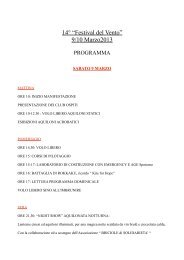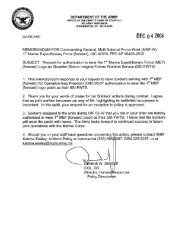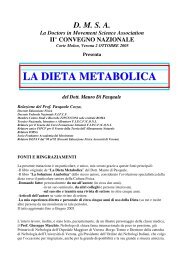Science vs. religion : what scientists really think - File PDF
Science vs. religion : what scientists really think - File PDF
Science vs. religion : what scientists really think - File PDF
Create successful ePaper yourself
Turn your PDF publications into a flip-book with our unique Google optimized e-Paper software.
No God on the Quad 89But change is afoot. Religion scholars John Schmalzbauer and KathleenMahoney contend that <strong>religion</strong> is coming back to the academy through burgeoningsocial movements that are concerned about revitalizing campus <strong>religion</strong>.After years of researching university and college ministries across thecountry, they find “strong evidence [that] indicates a new story needs to be toldabout <strong>religion</strong> in the academy, one that recognizes the resilience of the study ofthe sacred in a secular institution.” These scholars discovered that at least “fiftyreligious scholarly associations foster the integration of faith and learning,while newly created centers for the study of <strong>religion</strong> can be found at ColumbiaUniversity, the University of Virginia, Princeton University, New York University,and a host of other institutions.” 8 Just as previous funders supported thedemise of <strong>religion</strong> in the academy, new institutions are supporting its rise. Philanthropictrusts such as the Lilly Endowment, the Pew Charitable Trusts, andthe John Templeton Foundation 9 have funded interdisciplinary centers forresearch and programming in various disciplines that examine <strong>religion</strong>. Inaddition, the social sciences disciplines are taking the study of <strong>religion</strong> moreseriously. The American Psychological Association (APA), the American SociologicalAssociation (ASA), and the American Political <strong>Science</strong> Association(APSA)—some of the organizations Smith argued were part of the deliberatesocial movement to secularize American higher education—all now have largesections devoted to examining the place of <strong>religion</strong> in modern society. Andfoundations such as the Teagle Foundation have committed resources to thespecialized mission of developing models of character in higher education. 10Princeton University scholar of American <strong>religion</strong> Robert Wuthnow, in a 2003article in the Chronicle of Higher Education , argued for more “scientific studiesof <strong>religion</strong>.”11And the Metanexus arm of the Templeton Foundation has createdmore than 200 discussion groups on <strong>religion</strong> and science around thecountry, funding many of the U.S.-based and international centers that study<strong>religion</strong> and foster scholarly conversations on its connections to science.Plainly, scholars are making a place for <strong>religion</strong>.And so are students. Scholars of higher education such as Helen andAlexander Astin show that an increasing number of students (and faculty) arepracticing traditional forms of <strong>religion</strong> or are interested in broader ideas ofspirituality.12In general, <strong>religion</strong> is meaning more to today’s undergraduates,say <strong>religion</strong> scholars Conrad Cherry, Betty A. DeBerg, and Amanda Porterfield.According to their study of <strong>religion</strong> among students at four major U.S. universities,<strong>religion</strong> is “alive and well” among American college students. 13 Althoughtheir faith isn’t as officially linked to the university as it used to be, studentsare likely to utilize <strong>religion</strong> when they are not in church, as when prayingbefore sporting events or as a motivation to volunteer in their communities.
















